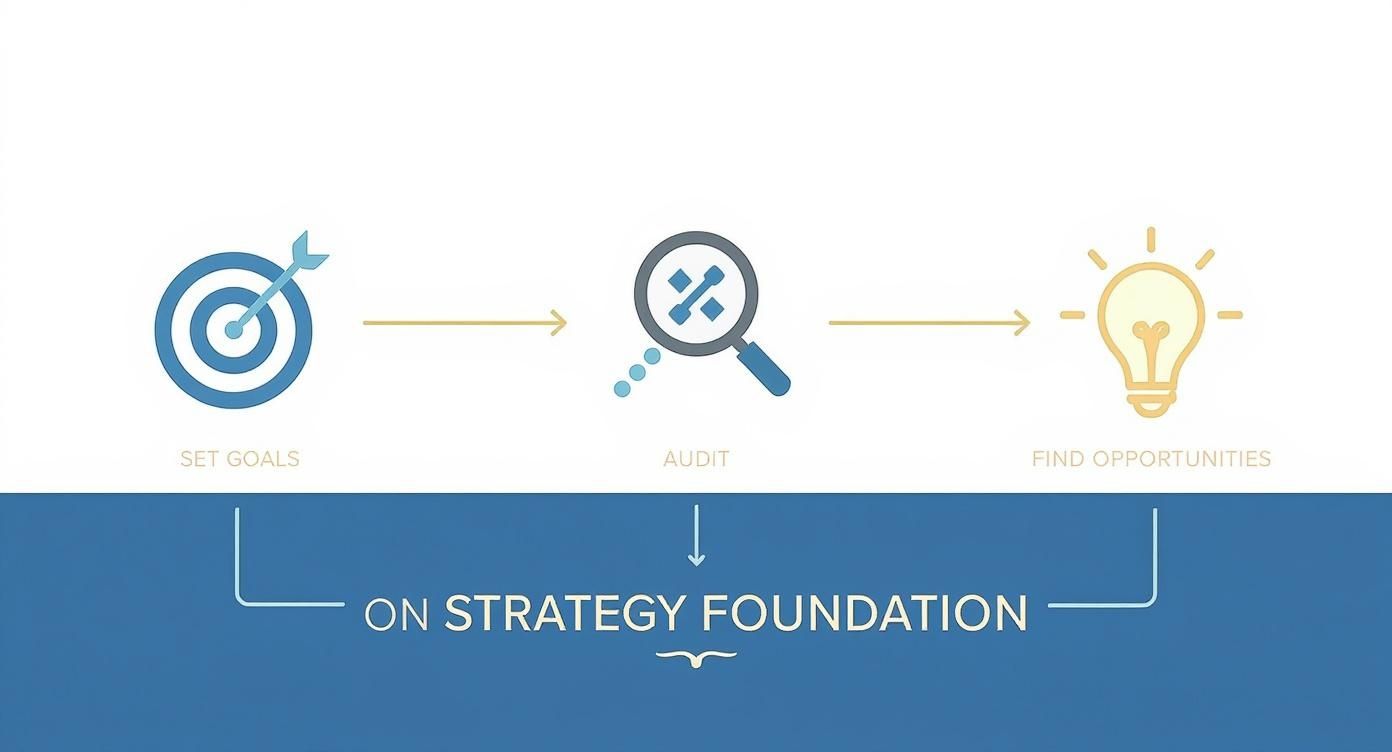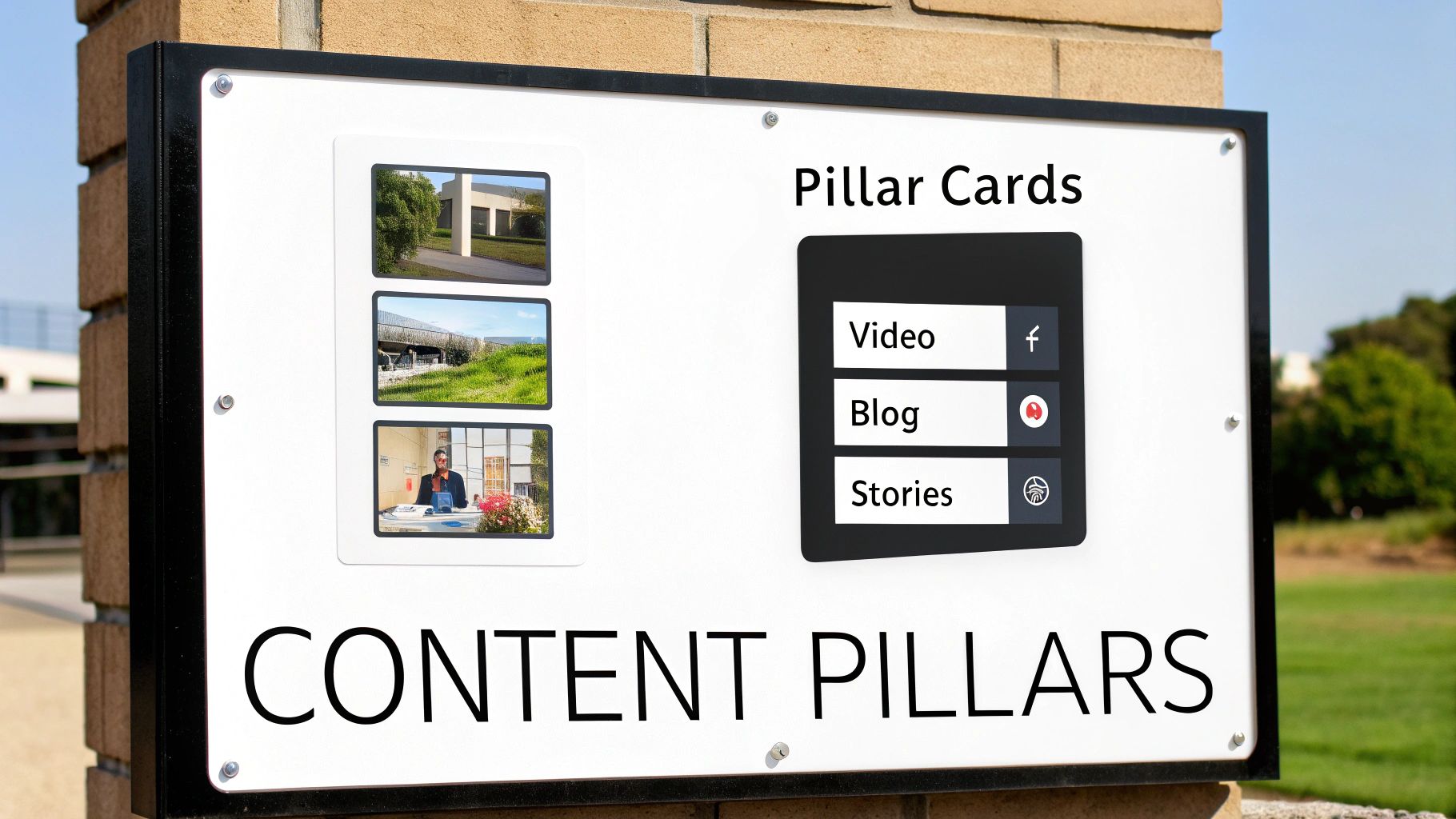A truly successful social media and content strategy isn't just about posting pretty pictures. It's a game plan—a detailed roadmap that guides every piece of content you create and share, all with the aim of hitting specific business goals. It’s the difference between shouting into the void and having a meaningful conversation with the right people.
Building Your Strategic Foundation
Before you even think about your next post, you need to lay some serious groundwork. It’s all too easy to get sidetracked by vanity metrics like follower counts, but a strategy that actually works is built on clear, measurable objectives tied directly to your company's growth. We're talking about real return on investment (ROI), not just making noise.
This first phase is all about setting goals that matter and taking a hard, honest look at what you’re already doing to find those hidden pockets of opportunity.
Define Your Business-Centric Goals
First things first: connect your social media activity to tangible business outcomes. What does "success" actually look like for your brand? You have to move past vague ambitions like "get more engagement."
A great way to do this is by using the SMART framework: Specific, Measurable, Achievable, Relevant, and Time-bound. This simple method turns fuzzy ideas into concrete targets. For instance, a goal like "increase brand awareness" becomes a powerful, actionable objective: "Increase brand mentions on X (formerly Twitter) by 20% in the next quarter by sharing user-generated content and engaging in industry conversations."
Here are a few more real-world examples:
- Generate More Leads: Bump up landing page click-throughs from LinkedIn by 15% over the next 60 days.
- Boost Sales: Drive a 10% increase in sales attributed to Instagram Shop promotions during the holiday season.
- Build Community: Grow our private Facebook group membership by 25% and hit a 50% active member rate within three months.
A winning social media strategy starts with clear objectives—without them, you can’t measure ROI. Focus on metrics that prove your work’s value, matching your goals to your business, and your metrics to your goals.
Conduct a Social Media Audit
With your goals locked in, it's time to figure out where you stand right now. A social media audit is just a straightforward review of your existing profiles to see what’s working, what’s a total flop, and where you can make improvements. Think of it less as a judgment and more as a data-gathering mission.
This process flow really breaks down those foundational steps: you set your goals, audit your current presence, and then you're ready to spot opportunities for growth.

This workflow drives home the point that a great strategy always starts with a clear purpose and a realistic look at your starting line.
As you go through your audit, ask yourself these tough questions for each platform:
- Is this platform still relevant? Is your target audience actually hanging out here? If not, it might be time to cut your losses.
- What content performs best? Start looking for patterns. Do video tutorials crush static images? Do carousels get more saves?
- Is our branding consistent? Check your profile picture, bio, and tone of voice. A cohesive look and feel builds trust and makes you instantly recognizable.
- Who is engaging with us? Are these your ideal customers? If the answer is no, your content might be missing the mark.
This audit gives you the baseline data you need to build a smarter strategy from the ground up. Once you understand your own performance and have a peek at what competitors are doing, you can find those gaps in the market that everyone else has missed. If you need a hand organizing your thoughts, this comprehensive social media marketing plan template can be a huge help. Putting in this foundational work ensures every bit of effort is focused, efficient, and aimed at what really moves the needle.
Truly Understanding Your Audience

You can have the most brilliant social media strategy in the world, but it will fall completely flat if it doesn't reach the right people. Content only truly connects when you know exactly who you’re talking to. And I don’t just mean their age and location.
The real goal is to get inside their heads and uncover why they do what they do online.
When you nail this, your content stops being generic noise and transforms into a resource your followers actually look forward to. You stop guessing and start creating posts that speak directly to their real-world needs, challenges, and dreams.
Moving Beyond Basic Demographics
Knowing your audience's age or gender is just scratching the surface. The gold is in the psychographics—their interests, their values, their biggest headaches, and how they spend their time online. This is how you build a detailed buyer persona that feels like a real person you're having a conversation with.
To get there, you need to ask deeper questions:
- What keeps them up at night? Figure out their biggest professional or personal pain points, and you'll know how to create content that offers a genuine solution.
- What gets them excited? When you align your content with their core values and motivations, you build a connection that goes way beyond just selling something.
- Where do they actually hang out online? Don’t just assume they’re on Instagram or Facebook. Pinpoint the specific platforms where they are most active and engaged.
- What kind of content are they already saving and sharing? Look at the accounts they follow. It’s a roadmap to what they find valuable.
Answering these questions is the first step in crafting a persona that will guide every single creative decision you make. For a more detailed walkthrough, check out our guide on how to define a buyer persona for your content strategy.
Practical Ways to Discover Your Audience
Gathering this kind of rich, qualitative data doesn't have to break the bank. There are some incredibly effective ways to listen in and learn directly from the people you want to reach.
Social Listening is your secret weapon. Using tools to track keywords, brand mentions, and what people are saying about your competitors gives you access to raw, unfiltered conversations. You’ll quickly learn the exact language your audience uses, the questions they’re asking, and what they really think about your industry. It’s a goldmine for content ideas.
Surveys and Feedback are another direct line. Seriously, just ask them what they want! Simple polls in your Instagram Stories or a quick survey sent to your email list can give you incredibly direct, actionable feedback on what's hitting the mark and what isn't.
The most effective content strategies are built on a foundation of empathy. When you stop creating for a faceless crowd and start creating for a specific person with real problems and aspirations, your entire approach changes for the better.
Analyzing Your Competitors' Audience
Here’s a great shortcut: your competitors have already done some of the work for you. By digging into their social media presence, you can find valuable clues about the audience you both share. Take a close look at who is commenting, liking, and sharing their content—these are the people you want to reach.
Pay attention to their home-run posts. What topics fire up the comments section? Which formats get the most shares? This isn't about copying them; it's about spotting gaps they might be missing and finding opportunities where you can step in and provide even more value.
Mapping Out the Customer Journey
Once you have a crystal-clear picture of your audience, the final piece is understanding their journey with you. How does someone go from not knowing you exist to becoming a loyal fan? Mapping this out helps you deliver the right content at the right time.
- Awareness Stage: They have a problem but might not have heard of you yet. Your content here should be helpful and educational—think blog posts, infographics, or quick tips that address their pain points without a hard sell.
- Consideration Stage: Now they're actively looking for solutions. This is where you can offer more in-depth content like case studies, webinars, or detailed comparisons that position you as the expert.
- Decision Stage: They're ready to pull the trigger. Content like customer testimonials, free trials, or an exclusive offer can be the final nudge they need.
With social media now being a primary channel for discovery, this journey mapping is more critical than ever. As of 2025, over 5.4 billion people—that's 65.7% of the global population—are on social media, and 58% of consumers say they discover new businesses there. According to Sprinklr, this trend is only growing, making it essential to meet your audience where they are.
Building Your Content Pillars and Themes
Ever tried to cook a gourmet meal by just grabbing random ingredients from the pantry? It usually doesn't work out. Posting on social media without a plan is pretty much the same thing—you end up with a confusing mess that doesn't really satisfy anyone. To avoid this, you need a solid structure, and that structure starts with content pillars.
Think of content pillars as the 3-5 big-picture topics your brand is an expert on. These are the core themes you'll return to again and again, establishing your authority and giving your audience a clear reason to follow you. Everything you create should tie back to one of these pillars. This simple framework ends the daily scramble for post ideas and ensures everything you share tells a consistent, compelling story about your brand.
From Big Ideas to Daily Posts
Once you have your pillars, it’s time to break them down into smaller, more specific subtopics. We call these content buckets. If your pillar is the main course, your buckets are the delicious side dishes that add flavor and variety.
Let's imagine you're a financial advisor. A huge pillar for you might be "Retirement Planning." That's a massive topic, so you could break it down into buckets like these:
- Early Career Savings: Posts about the magic of compounding or demystifying your first 401(k).
- Mid-Career Strategies: Content on catch-up contributions or diversifying your portfolio as your income grows.
- Pre-Retirement Checklist: Practical advice on healthcare costs, Social Security, and downsizing.
- Lifestyle in Retirement: Inspiring stories about travel, hobbies, and making your money last after you stop working.
Suddenly, you've gone from one vague topic to dozens of concrete post ideas. The "Early Career Savings" bucket alone could fuel an Instagram Reel on compounding, a detailed LinkedIn article on common 401(k) mistakes, and a quick-tip Twitter thread. This system gives you a never-ending well of relevant content that always points back to your core expertise.
To help you visualize this, here’s a simple framework showing how a pillar can branch out into specific ideas for different platforms.
Example Content Pillar and Bucket Framework
| Content Pillar | Content Bucket | Example Post Idea (Instagram) | Example Post Idea (LinkedIn) |
|---|---|---|---|
| Sustainable Living | Zero-Waste Swaps | A quick Reel showing 5 easy swaps for beginners in the kitchen. | A carousel post detailing the long-term financial benefits of adopting zero-waste habits. |
| Sustainable Living | Ethical Fashion | An "Outfit of the Day" post featuring brands with transparent supply chains. | An article analyzing the latest industry report on sustainability in fashion manufacturing. |
| Sustainable Living | Conscious Consumerism | A Story poll asking followers which sustainable product they want to learn about next. | A thought leadership piece on how businesses can champion conscious consumerism. |
This structure makes content planning less about frantic brainstorming and more about strategically filling in the blanks.
Give More Than You Take: The 80/20 Rule
Let's be honest: nobody follows a brand just to be sold to 24/7. People are on social media to learn, to be entertained, and to connect. This is where the 80/20 rule comes in, and it's a game-changer for building an audience that actually trusts you.
The rule is simple: 80% of your content should provide pure value to your audience. Only 20% should be directly promotional. This approach builds a loyal community that's far more receptive when you finally do ask for the sale.
For every five posts you share, four should be genuinely helpful, insightful, or fun. The fifth can be your sales pitch. Sticking to this ratio stops your feed from feeling like a constant commercial and positions your brand as a generous guide, not just another seller.
This value-first approach is more critical than ever. In 2025, social media strategy is heavily influenced by AI and what consumers now expect from brands. With over 80% of marketers already using AI tools for content creation and scheduling, the bar for quality is higher. You can dig deeper into these content marketing statistics and trends to see just how much things are shifting.
Mix It Up: Diversify Your Content Formats
A great strategy isn't just about what you say, but how you say it. Relying on a single content format is a surefire way to bore your audience. Instead, build a dynamic presence by mixing up the types of content you create.
Don’t get stuck just posting static images. Try experimenting with a variety of formats:
- Short-Form Video (Reels, TikToks, Shorts): These are gold for quick tutorials, behind-the-scenes content, and hopping on relevant trends.
- Carousels: Perfect for breaking down a complex idea into easy-to-digest, swipeable slides.
- Interactive Stories: Use polls, quizzes, and Q&A stickers to get your audience talking directly to you.
- Live Streams: Host an interview or an AMA (Ask Me Anything) session to build a real-time connection with your community.
- User-Generated Content (UGC): Sharing posts from your happy customers is one of the most powerful forms of social proof.
As you create content for your pillars—especially if you're using tools to help speed things up—remember the importance of humanizing AI-generated content. Your pillars give you the roadmap, but it's your authentic voice and creative formats that will actually capture and hold your audience's attention.
Building a Sustainable Content Calendar

Think of your content pillars as a well-stocked pantry—all your core ingredients are ready to go. But to actually make a meal, you need a recipe. That’s exactly what a content calendar is: the practical blueprint that turns your strategy into a manageable, day-to-day workflow.
This is the point where your social media and content strategy stops being a document and starts delivering results. A good calendar brings order to the chaos, ending the last-minute scramble for posts and making consistency feel effortless. It’s the essential bridge between your ideas and your goals.
Finding the Right Content Scheduling Tools
The "best" tool for the job is whichever one fits your team’s size and workflow. There's no one-size-fits-all answer here. What matters is finding something that solves your problems today and can grow with you tomorrow.
If you're a solo founder or have a tiny team, don't underestimate the power of a simple spreadsheet. A Google Sheet or an Airtable base is free, incredibly flexible, and gets the job done without a complicated setup. You can easily map out posts, track what’s due, and share it with a collaborator.
Once your team starts to grow, you'll feel the limitations of a spreadsheet. That's when it's time to look at dedicated platforms like Buffer, Hootsuite, or Sprout Social. They offer features that spreadsheets just can't handle:
- Direct Publishing: Schedule and automatically post content across all your channels.
- Approval Workflows: A must-have for getting feedback from managers or clients.
- Analytics Integration: See what's working (and what isn't) right inside the tool.
- Asset Libraries: Keep all your approved images, videos, and copy in one central spot.
My advice? Start simple. Only upgrade when your current system is genuinely holding you back. Don't pay for features you don't need yet.
The Sweet Spot: Planned vs. Spontaneous Content
A great content calendar is a framework, not a straitjacket. It needs to provide a solid foundation of planned posts while leaving you the flexibility to jump on trends, news, or unexpected conversations. I like to think of it as planning your main meals for the week but leaving room for a spontaneous dinner out with friends.
Your calendar should be filled out weeks—sometimes months—in advance with a few key categories:
- Evergreen Content: This is the stuff pulled directly from your content pillars that stays relevant. Think how-to guides, brand stories, and timeless industry tips.
- Campaign-Specific Content: All the posts tied to a product launch, a holiday sale, or a specific event.
- Key Dates and Holidays: Mark down industry conferences, national holidays, and any other important dates you can create relevant content around.
A well-built calendar doesn't kill creativity; it frees it up. By automating the predictable stuff, you create the mental space to react to the unpredictable—and that's often where the magic on social media happens.
If you want to dive deeper into this, our guide on building a powerful social media content calendar has templates and a ton of practical tips to help you get it right.
The Art of Smart Content Repurposing
Let's be real: creating truly good content takes a lot of time and energy. The secret to keeping a full calendar without burning out is to work smarter, not harder. This is where content repurposing becomes your best friend. It’s all about taking one big piece of content and slicing it into many smaller assets for different platforms.
This strategy gets the most mileage out of your best ideas and makes sure your message gets seen by more people in the formats they actually prefer. It's the ultimate efficiency hack.
Here’s a real-world example. Say you just hosted a one-hour webinar on "Beginner SEO Tips." Look at all the content you can create from it:
- Blog Post: Clean up the transcript and turn it into a comprehensive, keyword-rich article.
- LinkedIn Carousel: Pull out 5-7 of the best takeaways and design a simple, swipeable carousel.
- Instagram Reels: Find the most impactful 60-second moments from the video and clip them into short, punchy Reels.
- Twitter Thread: Break down the core concepts into a 10-tweet thread packed with actionable advice.
- Quote Graphics: Grab a few powerful one-liners from the speaker and turn them into shareable images for Instagram and Facebook.
Just like that, one hour of work has been multiplied into a full week of high-value, diverse content. This systematic approach is the engine of a sustainable strategy, keeping your calendar packed without demanding constant, from-scratch creation.
Measuring What Matters for Business Growth

Putting out great content is a fantastic start, but it's really only half the battle. If you want to build a social media and content strategy that actually works, you have to close the loop by measuring your results. Without that crucial step, you’re just throwing spaghetti at the wall and hoping something sticks. You end up wasting time and money on tactics that don’t move the needle for your business.
This is where so many brands get sidetracked. It’s easy to get caught up chasing vanity metrics like follower counts, but that data doesn’t really signal business growth. The real breakthrough happens when you shift your mindset from "How many likes did we get?" to "How did this post help us achieve our goals?" That’s when your strategy stops being a creative exercise and starts being a powerful, data-driven engine for growth.
Connecting Goals to Measurable KPIs
Every single metric you track should tie directly back to the business goals you established from the get-go.
For instance, if your main objective is to generate leads, your overall follower growth is far less important than your click-through rate (CTR) on a link to a lead magnet. This alignment is what gives your data purpose. It turns a spreadsheet of numbers into a clear story about your performance.
So, how do specific business objectives translate into the tangible Key Performance Indicators (KPIs) you should be watching? Let's take a look.
Connecting Business Goals to Social Media KPIs
This table breaks down how to align common business objectives with the specific, measurable KPIs you should be tracking on social media. It helps you filter out the noise and focus on what truly matters.
| Business Goal | Primary Social Media KPI | Secondary Metrics | Example Measurement |
|---|---|---|---|
| Increase Brand Awareness | Reach & Impressions | Follower Growth, Shares, Mentions | Tracking the total number of unique users who saw your content this month. |
| Drive Website Traffic | Click-Through Rate (CTR) | Clicks, Traffic Source Data | Monitoring the percentage of people who clicked the link in your bio from Instagram. |
| Generate New Leads | Conversion Rate | Cost Per Lead (CPL), Form Fills | Measuring how many users who clicked a social ad completed a sign-up form. |
| Build Community Loyalty | Engagement Rate | Comments, DMs, Saves, UGC | Calculating the percentage of your audience that interacts with your posts. |
Using a framework like this keeps you focused on the data that proves whether your strategy is hitting the mark or needs a few tweaks.
Using Platform Analytics to Your Advantage
You don't need to shell out for expensive software to start gathering powerful insights. Every major social media platform has its own built-in analytics dashboard, and they are packed with valuable information.
-
Instagram Insights: This is your go-to for understanding your followers. It gives you detailed demographic data, pinpoints the best times to post based on audience activity, and shows you which content formats (Reels, Stories, posts) are getting the most love.
-
Facebook (Meta) Business Suite: If you want a deep dive into your page's reach and engagement, this is the place. It's especially useful for tracking the performance of your paid ad campaigns and understanding audience behavior.
-
LinkedIn Analytics: For any B2B strategy, this is gold. It provides professional demographic data, showing you the job titles, industries, and company sizes of the people engaging with your content.
The most powerful insights often come from comparing performance across different platforms. You might discover that educational carousels excel on LinkedIn, while quick, entertaining videos are the key to growth on Instagram.
This kind of understanding is what allows you to really tailor your content to fit the unique culture and audience expectations of each channel.
The Power of A/B Testing
Once you have a baseline of data, you can start actively improving your results through A/B testing. It might sound technical, but it’s really just a simple process: test one small change at a time to see what performs better. This creates a powerful feedback loop where solid data, not just assumptions, drives your decisions.
The trick is to change only one variable at a time. If you change both the headline and the image in an ad, you'll have no idea which element was actually responsible for the change in performance.
Here are a few simple A/B tests you can start with:
- Test Your Call-to-Action (CTA): Run two identical ads, but change the CTA button on one from "Learn More" to "Sign Up Now." Which one drives a higher conversion rate?
- Experiment with Visuals: Post the same core message twice, but use a static image for one post and a short video for the other. Measure which format gets higher engagement.
- Refine Your Headlines: On a platform like LinkedIn, test a question-based headline against a statement-based one to see which captures more attention and clicks.
The investment in social media advertising continues to climb, with global spending projected to hit an astounding $406 billion by 2029. With mobile devices expected to generate 83% of this ad revenue, optimizing every part of your creative becomes absolutely essential for capturing audience attention. As you can explore in these social media statistics, the complexity of ad formats is pushing brands to be more data-driven than ever.
By continuously testing and refining your approach, you ensure your social media and content strategy evolves, adapts, and consistently delivers a measurable impact on your business growth.
Common Strategy Questions Answered
Even the most well-laid plans run into snags. Building a **social media and content strategy** is never a “set it and forget it” task—it’s a living thing that requires constant attention and adjustment. Let’s tackle some of the most frequent questions that come up.
This is where the rubber meets the road. Knowing how to handle these common challenges is what turns a strategy that just looks good on paper into one that actually drives real-world results.
Which Social Media Platforms Should I Use?
The urge to be on every single platform is strong, but it's a surefire way to spread yourself too thin and burn out. The real secret is to go deep, not wide. Focus your energy where you’ll get the biggest bang for your buck.
Instead of chasing trends, ask yourself a few key questions:
- Where does my audience actually hang out? Dig into your persona research. If you’re trying to reach B2B decision-makers, LinkedIn is a no-brainer. But if your target is Gen Z, you’d be wasting your time there when you should be on TikTok or Instagram.
- What kind of content are we good at creating? Be honest about your team's skills. If you have a video whiz on staff, leaning into Instagram Reels and TikTok makes perfect sense. If your strength lies in thoughtful, long-form content, a company blog or LinkedIn articles are a much better fit.
- Where are my competitors winning? A quick competitor audit can be incredibly revealing. You might find an untapped platform or confirm that the main conversations in your industry are happening exactly where you suspected.
How Often Should I Post?
This is the million-dollar question, and the answer is: consistency beats frequency every single time. Posting randomly is confusing for your followers and the algorithms. While there's no universal magic number, different platforms have different rhythms.
Here are some solid starting points:
- Instagram: Try posting 3-5 times per week on the feed. Use Stories daily to keep your brand top of mind.
- Facebook: Stick to 1-2 posts per day. Any more than that, and you might see your engagement start to dip.
- X (formerly Twitter): The feed moves fast here, so aim for 3-5 times a day to stay in the conversation.
- LinkedIn: This is all about quality over quantity. Posting 2-4 times per week with valuable, professional content is plenty.
My best advice? Start with a schedule you know you can stick to, then watch your analytics like a hawk. If you ramp up posting and see engagement fall off a cliff, dial it back. Let your data tell you what your audience wants.
What If My Strategy Is Not Working?
First things first: don't panic. A strategy that's perfect from day one is practically a myth. If you aren't seeing the results you hoped for, it’s a sign to investigate, not to scrap the entire plan.
Go back to basics. Is your content really what your audience wants to see, or is it just what you think they want? Are you positive you're on the right channels? Maybe your goals were a little too ambitious for your budget or timeline.
Often, it's the small, surgical tweaks that make the biggest impact. Before you burn it all down and start over, try A/B testing your headlines, experimenting with different visuals, or changing up your call-to-action. You'd be surprised how often a simple creative adjustment can be the key to getting your growth back on track.
Ready to stop wasting time on manual scheduling and put your evergreen content to work? With EvergreenFeed, you can automate your posting, keep your social media channels consistently active, and get more mileage out of your best content. Sign up for free and start saving hours today.




